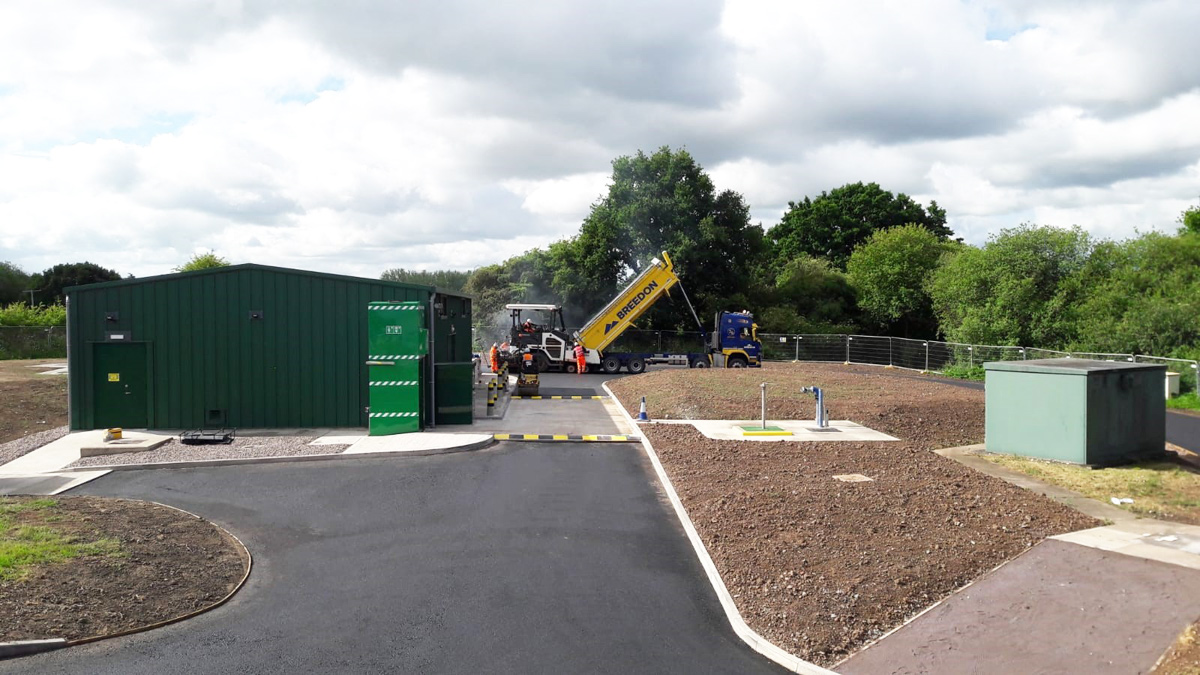Uckington Water Treatment Scheme (2021)

(left) New pumps and pipework installed at Shawbirch and (right) sand cyclones and internal pipework within the new treatment building - Courtesy of MMB and Severn Trent
The Uckington Borehole Capital Maintenance (BCM) and Restoring Sustainable Abstraction (RSA) Treatment Project set out to achieve the goal of an ecological improvement of the River Worfe while safeguarding the public water supply to the Telford area network. Over-abstraction from the River Worfe was impacting the achievement of Good Ecological Status under the Water Framework Directive, with abstraction of groundwater for public water supply being a major factor. Consequently, five existing water supply boreholes to the east of Telford were to be decommissioned. The Uckington scheme delivered improved flows from the opposite side of Telford to compensate for the decommissioned boreholes.
Existing sites
The works were carried out at 4 sites:
- Uckington: The ‘hub’ of the project was an existing site with 2 boreholes. A new treatment building was constructed at Uckington that houses water treatment equipment including cyclones to remove sediment from abstracted water and a chemical dosing system. Works were also carried out on the boreholes themselves with new pumps and headworks being installed.
- Shawbirch: Shawbirch is an existing booster station site that was upgraded with 3 (No.) new KSB pumps, pipework and a 35m3 surge vessel. A key factor of the works at Shawbirch was that the works had to be completed within two 13-day shut down periods to ensure the network could be kept in supply. This required extensive planning bringing in expertise from Severn Trent, MMB and several subcontractors.
- Nedge Hill: An existing DSR site had new pipework installed along with a flow meter and flow control valve to allow for increased flows to fill up the reservoir.
- Old Park: An existing DSR site that had valve modifications to allow for flow direction to be switched.

Construction of the steel frame portal treatment building – Courtesy of MMB
Project methodology
Design
The delivery team worked with their supply chain partners to build collaborative relationships early in the design phase. This promoted a ‘one team’ ethos and a ‘right first time’ approach. This collaborative approach enabled detailed knowledge of the network which proved imperative to the success of the scheme.
This, linked with the use of 3D modelling, enabled the team to design a safe buildable solution. The 3D models allowed the design team and client to clearly visualise the design and spot any ‘pinch points’ that were causing constraints and iron them out. The early engagement with the supply chain was important to drive MMB’s lean approach to design, construction, minimisation of waste and re-working. It was also crucial for meeting one of the principal challenges at the site; maintaining water supply throughout the construction works.
Health and safety were front of mind throughout the entire scheme and a number of positive design interventions were used to improve the construction and in-use phase of the scheme. This involved designs to avoid deep excavations, working at height and using dangerous tools on site such as angle grinders.
Construction
As per MMB policy, a strict induction course was in use so that everyone (including visitors) received site and role-specific inductions. A near miss system encouraged the spotting and sharing of unsafe conditions and behaviours to mitigate risks turning into incidents – on top of daily briefings which were held every morning.
All subcontractors were introduced to MMB’s safe systems of work (including operational safety standards), which ensured that high levels of safety were always maintained by all parties.
The site used a one-way system in place for the construction phase which then became the footprint for the access road for the final design. This one-way system allowed for the safe passage of vehicles during construction. When the site is in use the one-way road will allow chemical delivery without the need for the delivery vehicle to reverse or manoeuvre to get back off site.
Engineering difficulties
Key to overcoming difficulties on site was the scheduling of regular meetings with the client, site and design team and subcontractors. Some of the challenges are highlighted below:
- Engagement with key stakeholders to ensure the progress of a tight programme including 34 network interventions.
- Sourcing equipment from several specialist suppliers, including sand cyclones sourced from North America.
- Control of air flow through the treatment building to mitigate heat from the MCC, to keep the chlorine at its required temperature and removing condensation from the pipework.

Wearing course application – Courtesy of MMB
Engineering sustainable outcomes
Great coordination and cooperation between stakeholders ensured these outcomes were achieved whilst maintaining continuous supply without comprising water quality:
- Enabling achievement of Good Ecological Status under the Water Framework Directive for the River Worfe and its tributaries by allowing the closure of water supply abstraction of five boreholes in east Telford and the conversion of some to augment flows into the Worfe.
- Increasing water supply output from Uckington and providing the means to transfer increased output from the west of the Telford network to the east to compensate for loss of flows from the eastern boreholes.
- Enabling transfer of resilience flows from Shrewsbury to augment Telford’s network, ensuring availability of water to the whole of the Telford area.
Project successes
Financially successful
Several key decisions were made by the delivery team to reduce costs and add value to the project, including:
- The use of a steel portal frame rather than a large-scale GRP building.
- Controlling air flow within the treatment building using fans to control the temperature and humidity saved on costs installing air conditioning and the associated costs of running an air conditioning system.
- Efficient road design to avoid having to use a heavy-duty concrete construction.
- Maximising the expertise of in-house design team for many parts of the project such as process, civil and hydraulic design.
Exemplary health, safety and environmental (HSE) performance
This was achieved throughout the delivery of the scheme with the introduction of a number of measures by Site Manager Alastair Sayers and his team, ensuring an excellent approach to safety and successful management of potential environmental risks. These measures included:
- The introduction of sub-contractors to MMB’s Safe Systems of Work and Operational Safety Standards (OSS) – ensuring high levels of safety always maintained.
- Communication of audit findings and near misses.
- Numerous safety improvements were implemented, including elimination of trip hazards on the completed project and the removal of working at height risks for lighting maintenance.
- Use of MMB Environmentalists to ensure minimal impact on local land and brooks, with an area in the centre of the Uckington site left as a ‘wild area’ to promote biodiversity.

Completed site at Uckington – Courtesy of Severn Trent
Meeting and exceeding the client’s expectations
The reputation of MMB and the delivery team was further enhanced following a visit by Helen Miles (Capital and Commercial Services Director) who praised the health, safety, and quality of the scheme. By meeting regularly with the client, solutions/improvements were quickly agreed and implemented – including maintaining client access through appropriate programming, as well many health and safety related improvements. Familiarisation days and training for client operatives ensured regular feedback, and visits to similar sites provided further best practice ideas/key learning.
Successful public interaction
The delivery team did an excellent job liaising with local landowners. Improvements were made to an area of a nearby farmer’s land to reduce flooding and remove stagnant water.
Teamwork and leadership
Key to successful delivery was clear communication and organisation between all parties involved, and the diligent planning used to pull together designers, the commercial team and management. This was backed up by the site team, who were able to progress the works without delay due to the availability of designs, materials and clear instructions.
Efficient supply chain management
Through using MMB’s well-established systems and procedures, and drawing on previous experiences, the team utilised the most suitable subcontractors/suppliers; confident in their performance and that health and safety standards would meet MMB’s strict criteria.
Careful planning between the delivery team meant supply chain management was effective and well programmed throughout, avoiding any lost time. The teamwork approach was always promoted, encouraging the supply chain to work with an excellent, safe site. The team also helped to integrate the supply chain’s management systems into MMB quality control procedures; considering their methodology to maximise safety.
Uckington Water Treatment Scheme: Supply chain – key participants
- Principal designer & contractor: MMB
- Treatment building superstructure: Robinson Structures
- Above ground process pipework: Alpha Plus Ltd
- Electrical installation: PCS
- Hypochlorite rig design and installation: IIES (Northern) Ltd
- Booster pipework and pump installation: Watermark Systems UK
- MCC design and installation: Boulting Group
- Washout pipe installation: Hollywood Civil Engineering
- Surge vessel: Quantum Engineering Developments Ltd
- Miscellaneous metalwork: WJW Engineers
- Borehole pump installation: Midland Pump Manufacturing
- Borehole pumps: Wilo (UK) Ltd
- Booster pumps: KSB Limited
- Sand cyclones: Evoqua Water Technologies (Xylem Water Solutions)
- GRP kiosks: Morgan Marine
- DI pipework: Saint Gobain PAM UK
- DI pipework: Electrosteel Castings (UK) Ltd
- Flow meters: ABB Ltd
- Turbidity monitors: Sigrist Photometer
- Flow control: AFFCO Flow Control (UK) Ltd
- Flow control valve: AVK UK Ltd
- Static mixer: Statiflo International
- Chemical interceptor: SPEL Products
- 3-way valve: ISS Safety
- Safety shower: Hughes Safety Showers
Conclusion
Through effective planning and collaboration with all parties, regular communication and knowledge sharing, timely delivery was achieved, with the project completed in March 2020; on time and without any interruption to supply.
Collaborative working and an excellent team ethos enabled the successful delivery of this £8.8m ‘fast-track’ scheme to alleviate over-abstraction from the River Worfe and safeguard public water supply to the Telford area.








